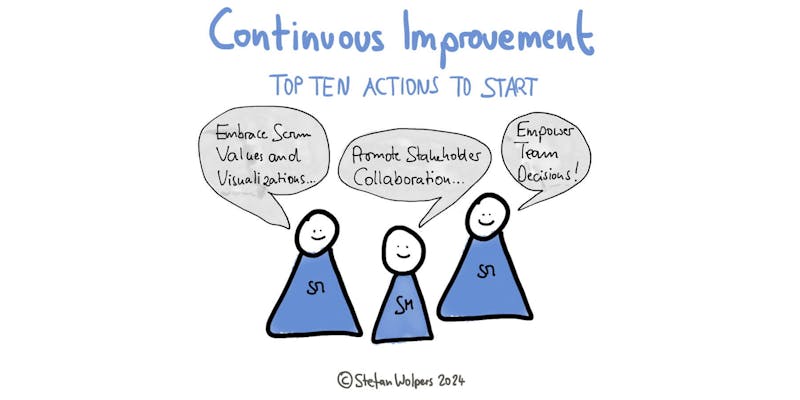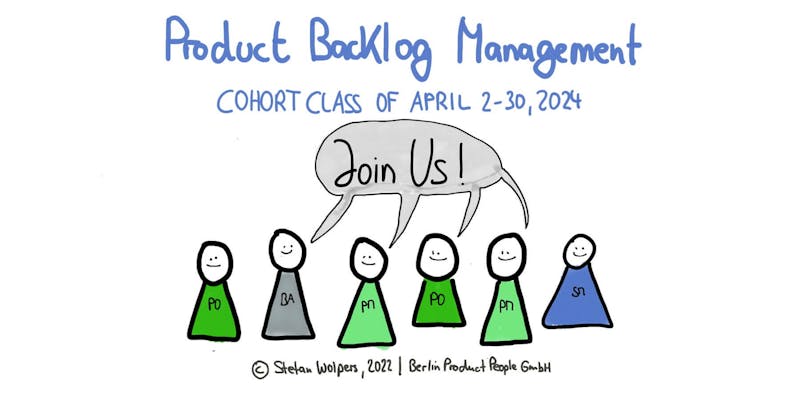|
Cultivating a culture of continuous improvement within Scrum teams or Agile teams is pivotal for personal well-being, enhancing effectiveness, building trust with stakeholders, and delivering products that genuinely enhance customers' lives. (Read online.)
This post dives into the top ten actionable strategies derived from the Scrum Anti-Patterns Guide book, providing a roadmap for teams eager to embrace Kaizen practices. From embracing Scrum values and fostering psychological safety to prioritizing customer feedback and continuous learning, these strategies offer a comprehensive approach to fostering innovation, collaboration, and sustained improvement.

The most popular discussion on LinkedIn last week was: #How to Best Sabotage a Scrum Master?

🎓 May 30, 2024: Step into Expertise: Secure Your Spot in Advanced Product Backlog Management Course for Just $149!
My Top Ten Continuous Improvement Actions for Teams
To foster a culture of continuous improvement and embrace Kaizen practices, here are enhanced suggestions for Scrum or Agile teams looking to improve their effectiveness, build trust with stakeholders, and deliver products that significantly impact customers’ lives:
-
Regular and Reflective Retrospectives:
- Importance: Conducting regular Retrospectives enables teams to pause and reflect on their past actions, practices, and workflows, pinpointing both strengths and areas for improvement. This continuous feedback loop is critical for adapting processes, enhancing team dynamics, and ensuring the team remains agile and responsive to change.
- First Step: Guarantee the consistency of your Retrospectives at every Sprint's conclusion. Before these sessions, collaboratively plan an agenda that promotes openness and inclusivity. Facilitators should incorporate practices such as anonymous feedback mechanisms and engaging games to ensure honest and constructive discussions, setting the stage for meaningful progress and team development.
-
Implement Improvement Actions:
- Importance: Actioning identified improvements demonstrates the team’s commitment to continuous enhancement and ensures that insights gained from Retrospectives and feedback are put into practice, leading to tangible benefits and progress.
- First Step: At the end of each Retrospective, work together to prioritize improvement actions and decide on clear ownership. Integrate these actions into your team’s workflow, tracking them on the Kanban board or task list like any other task. Regularly review their progress in subsequent Retrospectives to confirm they’re on track for completion and to evaluate their impact, ensuring these efforts lead to meaningful improvements in your processes and outcomes. Offer support when responsible individuals struggle to make progress.
-
Embrace Scrum Values:
- Importance: Integrating Scrum values deeply into the team’s ethos fosters a work environment conducive to continuous improvement. These values guide behaviors and decision-making processes, ensuring that every team member is aligned and committed to the principles of Scrum, thus enhancing collaboration and effectiveness.
- First Step: Host a dedicated session where the team collaboratively discusses each Scrum value and identifies specific actions or behaviors that exemplify these values in their daily work. Create a team charter or working agreement that incorporates these values and commits to holding each other accountable—as professionals do.
-
Build Psychological Safety:
- Importance: Psychological safety is the foundation of a team’s ability to innovate, take risks, and communicate openly without fear of negative consequences. It is essential for fostering an environment where continuous improvement can thrive, as team members feel comfortable sharing ideas, challenges, and feedback.
- First Step: Kick off an assessment of the team’s current psychological safety status through anonymous surveys. Follow up with a workshop focused on active listening, empathy building, and conflict resolution skills. Regularly check in on progress and set psychological safety as a recurring agenda item in Retrospectives. Also, reach out to the leadership level when the team’s safety is compromised at the organizational level to initiate a discussion on how to improve the situation.
-
Promote Stakeholder Collaboration:
- Importance: Effective stakeholder collaboration ensures the team’s efforts align with the broader business goals and customer needs. Engaging stakeholders throughout the development process invites diverse perspectives and feedback, which can highlight unforeseen areas for improvement and ensure that the product development is on the right track.
- First Step: Engage your stakeholders as a team, starting with the Sprint Reviews. Moreover, develop clear communication channels and feedback mechanisms to facilitate ongoing dialogue; you want feedback from your stakeholders not just at the Sprint Review. Remember to tailor the communication to meet your stakeholders’ needs; sometimes, this may require a written report. From time to time, consider offering joined stakeholder-team Retrospectives.
-
Empower Team Decision-Making:
- Importance: Allowing the team to make decisions about their work increases their sense of ownership and responsibility towards the outcomes. This level of self-management is crucial for fostering an environment where continuous improvement is driven by those closest to the work, leading to more effective and timely improvements.
- First Step: Begin by crafting a decision-making framework that encourages collaboration and aims for unanimous agreement rather than starting with a consent-based or majority-decision-based model. Jumping straight into consent or majority decisions can hinder team unity and lead to the formation of factions. Apply this inclusive approach to decisions identified during Retrospectives. It provides a platform for the team to practice and refine their collective decision-making skills, ensuring every team member’s viewpoint is acknowledged and valued.
-
Utilize Visual Management Tools:
- Importance: Visual management tools like Kanban boards provide transparency about work progress, priorities, and bottlenecks. This visibility helps the team manage their workflow more effectively, identify improvement opportunities, and make informed decisions.
- First Step: Collaboratively establish or enhance your Kanban board to ensure it genuinely represents the team’s workflow. It should incorporate features like columns or signals for work-in-progress limits, blocked tasks, and quality control checkpoints. Make it a routine to assess and update the board in Retrospectives, adapting it to evolving team needs and processes. Consider techniques like “walking the board” during Daily Scrum sessions.
-
Focus on Customer Feedback:
- Importance: Prioritizing customer feedback grounds the team’s efforts in real user needs and experiences, driving improvements directly relevant to customer satisfaction and product success. It ensures the team remains focused on delivering value and solving the right problems.
- First Step: Establish a systematic process for gathering feedback, which could involve organizing user interviews, deploying surveys, or conducting beta testing sessions. Integrate regular feedback review periods into Retrospectives, Sprint Planning and Sprint Review sessions, or Product Backlog refinement meetings to ensure customer insights are continuously woven into the development cycle.
-
Cultivate a Growth Mindset:
- Importance: Encouraging a growth mindset within the team fosters an attitude of learning and resilience. It helps team members view challenges and setbacks as opportunities for growth, driving personal and team development and innovation.
- First Step: Facilitate a workshop on understanding and embracing a growth mindset, featuring exercises to dismantle fixed mindset beliefs. Motivate team members to identify and pursue personal development objectives and to frequently exchange insights and achievements, possibly through mechanisms like a ‘learning log’ or in the context of Sprint Retrospectives.
-
Continuous Learning and Skill Development:
- Importance: Investing in continuous learning and skill development ensures the team remains adaptable and capable of overcoming new challenges. It supports the evolution of team capabilities and the introduction of innovative solutions, keeping the team and product at the forefront of industry trends.
- First Step: Allocate a specific time each Sprint for team members to engage in learning activities, such as online courses, workshops, and brown-bag, pair- or mob programming sessions. Promote disseminating newly acquired knowledge and abilities via ‘learning showcases’ or internal mini-workshops, fostering a shared growth and expertise culture.
🎓 🖥 💯 🇬🇧 Product Backlog Management Cohort Class of April 2-30, 2024
Discover the Product Owner success principles in this guaranteed engaging Product Backlog Management cohort class and accelerate your professional growth and career perspective with tried & tested, hands-on practices:
- Excel at delivering value regularly — your #1 career success factor.
- Learn to distinguish between valuable and useless ideas.
- Abandon the feature factory. Instead, learn to contribute to customer and organizational success.
- Gain actionable insights, learn supportive tools, and practice everything in a safe community of like-minded peers.
- Learn to say no and build trust and rapport with stakeholders while focusing on creating value.
- Create engaging feedback loops.
Enjoy the benefits of an immersive cohort class and its community with like-minded agile peers on April 2, April 16, and April 30, 2024, from 4-7 pm CEST. The class will be offered in English.

👉 Join now: 🖥 💯 🇬🇧 Product Backlog Management Class of April 2-30, 2024.
Additional Considerations for Continuous Improvement
While the strategies provided offer a solid foundation for fostering a culture of continuous improvement within Scrum and Agile teams, remember that the journey towards improvement is ongoing and unique to each team’s context. Here are a few additional considerations:
-
Customization is Key: Adapt these strategies to fit your team’s specific needs, challenges, and dynamics. What works for one team may not work for another.
-
Measure Progress: As a team, establish metrics or indicators to track the effectiveness of implemented changes. Measuring progress helps understand the improvements’ impact and guides further adjustments.
-
Leadership Support: Ensure leadership is on board and supportive of these initiatives. Their backing can significantly influence the success of efforts to foster a continuous improvement culture.
-
Celebrate Successes: Recognize and celebrate the successes, no matter how small. Acknowledging achievements boosts morale and reinforces the value of the continuous improvement efforts.
-
Stay Patient: Change takes time. Encourage patience and persistence among team members. Continuous improvement is a marathon, not a sprint; the benefits accumulate over time.
By considering these additional points, you will be better positioned to navigate the complexities of implementing continuous improvement practices and cultivating a resilient and innovative team culture.
Conclusion
Embracing continuous improvement through these ten strategies is crucial for Scrum and Agile teams aiming to elevate their performance and product quality. By regularly reflecting on practices, including everyone on the team, and focusing on customer-centric solutions, teams can foster a dynamic environment where innovation flourishes.
Implementing these suggestions will improve team dynamics and stakeholder relationships and ensure that products continually evolve to meet and exceed customer expectations. Start small, prioritize actionable changes, and build momentum toward cultivating a robust culture of continuous improvement and excellence in your team’s journey.
How does your team practice continuous improvement? Please share your experience with us in the comments.
📖 Continuous Improvement — Related Posts
Scrum: 20 Sprint Planning Anti-Patterns
Daily Scrum Anti-Patterns: 24+2 Ways to Improve as a Scrum Team
15 Sprint Review Anti-Patterns Holding Back Scrum Teams
21 Sprint Retrospective Anti-Patterns Impeding Scrum Teams
Download the Scrum Anti-Patterns Guide for free.
📅 Training Classes, Meetups & Events
Upcoming classes and events:
See all upcoming classes here.

If you have friends or colleagues who might be interested in this article as well, please forward this email—it would mean the world to me!
Have a great day!
Best,
|

